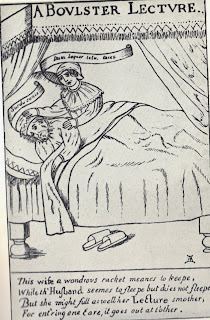An excellent
study day on Saturday with MEDATS, held in the bowels of the British Museum.
What follows is my impression of the papers given; any mistakes or
misunderstandings are my own.
 |
| From the Trachtenbuch, the left hand outfit has been reproduced |
The
first speaker was Jenny Tiramani with the 1530 outfit from Matthaus Schwarz
that she produced for the University of Cambridge. For those who haven’t seen
this there is an excellent video online at http://www.cam.ac.uk/research/features/the-first-book-of-fashion. There was some discussion about
the compromises that had had to be made, partly because of budget constraints.
Also the model was a slightly different size and shape from the person it was
made for, resulting in comments to the effect that it would never meet in the
middle – it did. The comment was also made that, when dressing someone, a lot
of time was spent arranging the person so they looked perfect. There were
questions about the weight of the aiguillettes, and how this affected how they
sat and how they needed to be attached, and how things laced together. The
entire Trachtenbuch
des Matthaus Schwarz aus Augsburg,1520 – 1560 is available in full online.
The
next speaker was Kathleen O’Neill on Nicolette: Action Transvestite. The second
part of the title comes from Eddie Izzard, “I'm an
action transvestite! ‘Cause it's running, jumping, climbing trees, you know.”
These are the things Nicolette does while dressed as a man. The chantefable of Aucassin and Nicolette was not one I knew,
and it was interesting to look at a heroine who not only cross dresses to get
her man, but also dyes her skin darker. Kathleen is planning to put this on her
blog at http://victorianlibrarian.wordpress.com/ but I don’t think it
is there yet.
The third of the morning speakers was Sarah Thursfield on lacing
in fact and fiction. Sarah started with some modern images that come up if you
put medieval lacing in Google images, but she spared us the renaissance wench.
Modern depictions show lacing that is entirely without function, and it is
possible to trace ideas back to early (19th century) costume
historians like Planche and Fairholt. Sarah argued that in the medieval period
lacing was as ubiquitous and functional as zips used to be, before they became
a fashion statement. The use of lacing was traced through the rise of more
fitted clothes for both men and women, and the placing of it on the side, front
or back of the garment. The Third Temptation of Christ in the Winchester Psalter of c.1150, was examined, where the devil wears lacing. Sarah said that Margaret Scott had commented that the devil's clothes are half male, half female. The side slit and the lacing are from men's wear, and the very long sleeve and skirt are from women's wear.
 |
| Book available from the BBC |
After lunch and the AGM Chris Carnie explored the work she had
done researching and making Ruth Goodman’s c.1500 outfit for the television
series “The Tudor Monastery Farm” Chris based her
work on some of the very few depictions of lower class women that exist,
especially for England. She showed a woodcut from the Sarum Book of Hours of
1507, an illustration of February from the Grimani Breviary of 1515-20,
and material from the Hours of Henry VIII of c1500. Chris
created a smock, kirtle, gown, kerchief, filet, rail, apron and cloth stockings
that Ruth can be seen wearing in the programme. A book to accompany the series
is available. The wear that the outfit received during the filming was
discussed.
The final speaker of the day was Johannes Pietsch looking at the
Fashionable Silhouette in the Middle Ages. He began his examination of the silhouette
with Superbia (pride) on horseback
in the Hortus Deliciarum of Herrad of Landsberg, Alsace. The Hortus was started
in c.1167 and Johannes worked his way through to the fascinating Erasmus
Grasser statues c.1480, of Moriskentänzer (morris dancers) in the Munich City Museum. On the way he took
in the garments, which he described as jaque not pourpoint, of Charles de Blois and Charles VI, this
lead to a questioning as to whether fashion follows armour, or armour follows
fashion.



